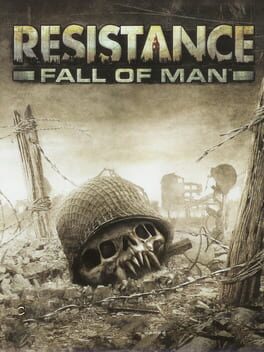In both good ways and bad ways, Insomniac's first PS3 shooter is very much a PS2-era shooter. Friendly AIs don't do much, enemy AI is one-dimensional, level design is very much contained corridors and segmented small arenas, gunplay is almost entirely focused on how guns actually work instead of how they interact with the enemies, and of course, the health system. This game's direct lineage can be traced to console Medal of Honor games, especially with segmented level design with illusions of bigger events that does not do very well in masking the game's archaic designs.
Guns themselves feel good, yes, and they do feel good enough when shooting in general, but it does not feel good when actually trying to shoot enemies. It's not just the outdated zoom-in on R3 that hinders this--it's how the damage feedback on enemies work. When you shoot at enemies, there are basically three enemy responses to damage: they die, they fall to their knees and get back up right away, or they simply do not react to being hit. Most of the time, enemies take quite a few rounds to even get their health down to where they fall to their knees, and so, they simply eat your bullets and fire back. This means there really is no real clever solutions to dealing with waves of enemies other than using explosive weapons, especially when crouching behind covers often doesn't mean much and the enemy bullets still somehow damage you. The nature of gunplay, enemy design and placement all encourages you to move around while taking some inevitable damage.
However, the health system is designed in the opposite way. It has segmented health where you will regenerate a portion of health when you are out of combat for long enough, while recovering the lost portions is done through health packs. The problem is that while it looks like a good compromise between the two polar opposites on paper, it ends up highlighting the negatives of both systems. During firefights, you are supposed to move around like old shooters, but because of how health regen works, you are also forced to take cover. The game seems to be at odds with its own systems here.
AIs in general also leave a lot to be desired. There really is no depth in terms of the enemy response to your actions, as they all basically follow one-dimensional combat patterns over and over again. As for the friendly AIs, they are rarely of any use, and can't even stay alive long enough to give a false sense of scale.
Overall, it's a fun romp for what it is, but it definitely gets tiring before the end credits roll. Locking cool weapons for a second playthrough is also kinda cheap too.
Guns themselves feel good, yes, and they do feel good enough when shooting in general, but it does not feel good when actually trying to shoot enemies. It's not just the outdated zoom-in on R3 that hinders this--it's how the damage feedback on enemies work. When you shoot at enemies, there are basically three enemy responses to damage: they die, they fall to their knees and get back up right away, or they simply do not react to being hit. Most of the time, enemies take quite a few rounds to even get their health down to where they fall to their knees, and so, they simply eat your bullets and fire back. This means there really is no real clever solutions to dealing with waves of enemies other than using explosive weapons, especially when crouching behind covers often doesn't mean much and the enemy bullets still somehow damage you. The nature of gunplay, enemy design and placement all encourages you to move around while taking some inevitable damage.
However, the health system is designed in the opposite way. It has segmented health where you will regenerate a portion of health when you are out of combat for long enough, while recovering the lost portions is done through health packs. The problem is that while it looks like a good compromise between the two polar opposites on paper, it ends up highlighting the negatives of both systems. During firefights, you are supposed to move around like old shooters, but because of how health regen works, you are also forced to take cover. The game seems to be at odds with its own systems here.
AIs in general also leave a lot to be desired. There really is no depth in terms of the enemy response to your actions, as they all basically follow one-dimensional combat patterns over and over again. As for the friendly AIs, they are rarely of any use, and can't even stay alive long enough to give a false sense of scale.
Overall, it's a fun romp for what it is, but it definitely gets tiring before the end credits roll. Locking cool weapons for a second playthrough is also kinda cheap too.
